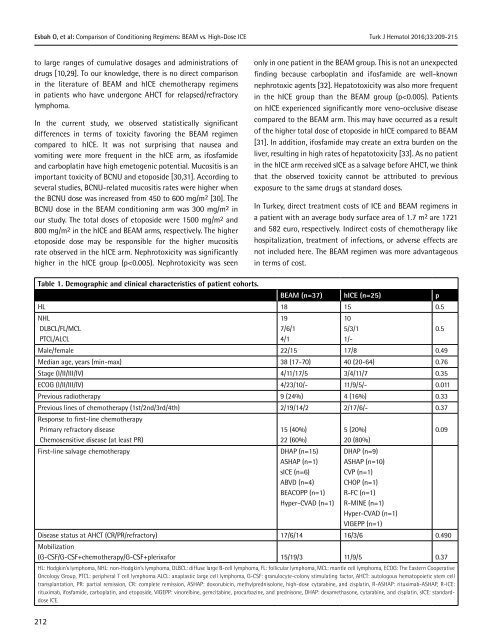Turkish Journal of Hematology Volume: 33 - Issue: 3
You also want an ePaper? Increase the reach of your titles
YUMPU automatically turns print PDFs into web optimized ePapers that Google loves.
Esbah O, et al: Comparison <strong>of</strong> Conditioning Regimens: BEAM vs. High-Dose ICE Turk J Hematol 2016;<strong>33</strong>:209-215<br />
to large ranges <strong>of</strong> cumulative dosages and administrations <strong>of</strong><br />
drugs [10,29]. To our knowledge, there is no direct comparison<br />
in the literature <strong>of</strong> BEAM and hICE chemotherapy regimens<br />
in patients who have undergone AHCT for relapsed/refractory<br />
lymphoma.<br />
In the current study, we observed statistically significant<br />
differences in terms <strong>of</strong> toxicity favoring the BEAM regimen<br />
compared to hICE. It was not surprising that nausea and<br />
vomiting were more frequent in the hICE arm, as ifosfamide<br />
and carboplatin have high emetogenic potential. Mucositis is an<br />
important toxicity <strong>of</strong> BCNU and etoposide [30,31]. According to<br />
several studies, BCNU-related mucositis rates were higher when<br />
the BCNU dose was increased from 450 to 600 mg/m2 [30]. The<br />
BCNU dose in the BEAM conditioning arm was 300 mg/m2 in<br />
our study. The total doses <strong>of</strong> etoposide were 1500 mg/m2 and<br />
800 mg/m2 in the hICE and BEAM arms, respectively. The higher<br />
etoposide dose may be responsible for the higher mucositis<br />
rate observed in the hICE arm. Nephrotoxicity was significantly<br />
higher in the hICE group (p

















